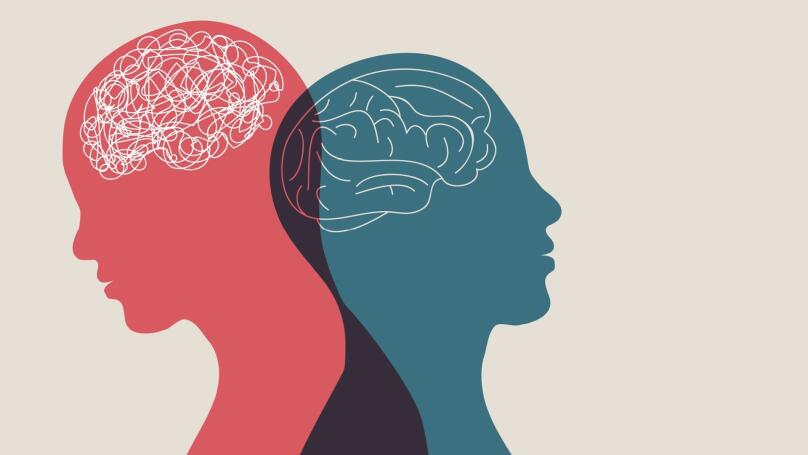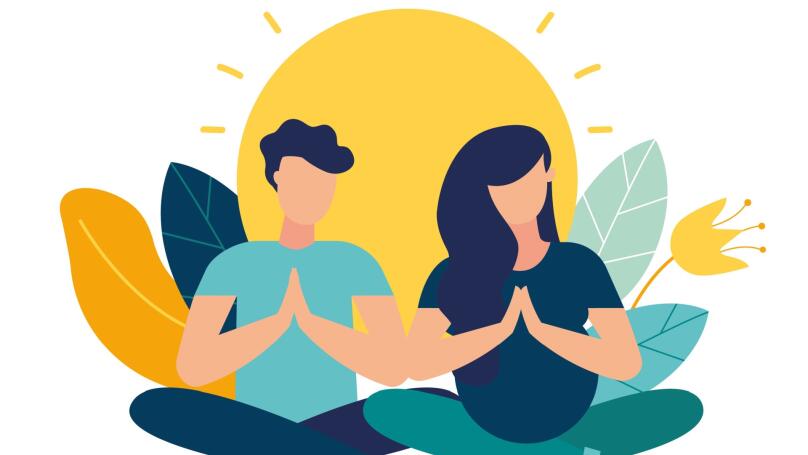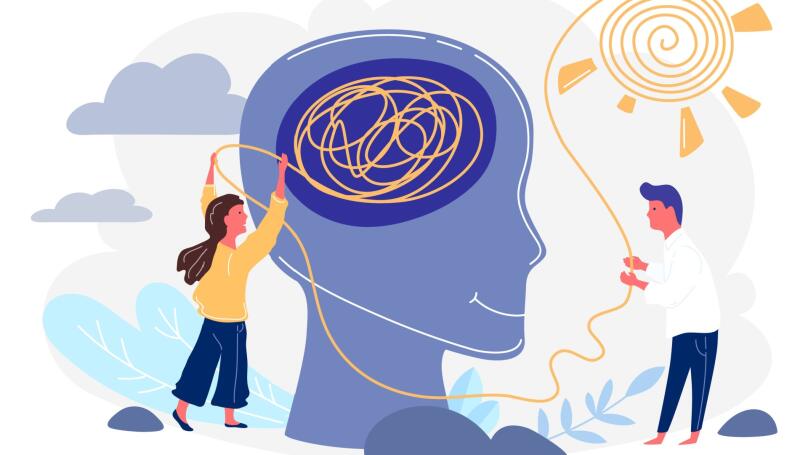Mindfulness

What is Mindfulness?
Mindfulness is a global trend. In psychology, it means listening to yourself, tracking your feelings and thoughts in the present moment, and analysing them without evaluation.
Essentially, mindfulness is a scientifically proven effective practice of focus training and stress management. It places an emphasis on deep awareness of current events, perception of the environment and one's emotional state, physical sensations, and emotions. That's why mindfulness meditations are recommended to everyone without exception, regardless of profession and age.
How the Concept of Mindfulness Appeared
Back in the early 1980s, Jon Kabat-Zinn, a professor of medicine at the University of Massachusetts, proposed the term mindfulness. The scientist assumed that every person can maximise mindfulness, which you should actively develop, as it increases efficiency and improves inner well-being and quality of life.
The fact that Kabat-Zinn took Buddhist practices as the basis of his concept caused a wave of scepticism on the part of his colleagues. However, he completely abandoned their religious component and left only the principles of use. There are tangible similarities between meditation and mindfulness in that both refer to training the mind and attention. After all, meditation and mindfulness practices involve turning on maximum concentration and immersing oneself in the present. Simultaneously, perception in mindfulness and Buddhist meditations should be non-judgemental and objective to become an "observer" of what is happening and one's emotions without distortion or influence.
Kabat-Zinn even opened his clinic, where he worked with patients using his methodology of MBSR, or Mindfulness-Based Stress Reduction. This unique two-month course taught Kabat-Zinn's patients stress reduction techniques and mindfulness practices. MBSR is now officially recognised by the scientific community and used extensively throughout cognitive behavioural therapy.
Why is Mindfulness Important?
Developing mindfulness allows you to avoid, or at least control, the "wandering mind" phenomenon. It is a well-known condition in which a person cannot concentrate on a particular task and is constantly distracted. For example, after only five minutes of a meeting, you are already thinking about how you will spend your holiday. A wandering mind also makes itself known when most students unknowingly start scrolling through their social media feeds after ten minutes of a lecture. Not only does this contribute to chronic procrastination, but it also makes recognising our inner state and emotions challenging.
Matt Killingsworth, developer of the happiness measurement app Track Your Happiness, believes that almost 50% per cent of the time, people don't even think about what they're doing at any given time. That said, he states: "Want to be happier? Live in the present." Austrian psychiatrist Viktor Frankl also talked about this. He believed that someone who rides in a tram and reads a newspaper but does not notice the sunset outside the window is irresponsible about their life.
Thus, according to conventional scientific opinion, lack of mindfulness makes people unhappy, limits them, makes them think in patterns and prevents them from seeing new perspectives. Moreover, the so-called autopilot mode promotes destructive criticism and constant evaluation of something, and because of this, a person may experience obsessive negative thoughts.
The Benefits of Mindfulness

Mindfulness practice significantly impacts a person's cognitive abilities and mental and physical health. Other benefits of mindfulness include:
- Improving memory, developing curiosity, and enhancing learning ability;
- Combating the symptoms of depression;
- Reducing levels of stress, anxiety, and worry;
- Managing one's own emotions and actions;
- Development of creative thinking and imagination;
- Improving sleep quality and overall quality of life;
- Improving immune function, i.e. the body's defence against infections, toxins, microbes, and various antigens.
Thus, mindfulness is a valuable tool for achieving long-term well-being in various areas of life because mindfulness is a universal concept based on training attention, concentration, and awareness, which are the foundation of any activity.
Mindfulness in Education
Mindfulness is famous in psychology, the lifestyle agenda, and academia. Researchers have concluded that educational institutions, particularly schools, are the best places to introduce mindfulness practices and develop mindfulness from childhood because it is during this period that personality formation takes place.
Conscious education implies the purposeful inclusion of mindfulness practices and following other trends that increase children's participation in learning. These include gamification of learning, an adaptive or personalised approach, and so-called holistic education aimed at the individual's all-around education.
Also, the key objectives that define mindfulness in education involve the following:
- Children's achievement of self-awareness, i.e. understanding of themselves, their emotions, and their causes;
- Awareness of their desires, interests, and needs;
- The ability to empathise, understand the feelings of others and show empathy;
- Development of communication skills, the ability to express and communicate one's thoughts competently;
- The ability to resolve conflicts constructively, negotiate and reach a compromise;
- Applying the learnt mindfulness skills in everyday life.
Additionally, practising mindfulness in schools enables children to develop emotional and social intelligence, effectively manage stress, anxiety, and worry, and improve concentration and memory. Children today face an unprecedented amount of stress and anxiety. According to the National Institute of Mental Health, an anxiety disorder is found in 25% of adolescents between the ages of thirteen and eighteen. According to the American Academy of Pediatrics, this early level of stress negatively affects children's learning outcomes and behaviour, as well as their physical and mental health. Meanwhile, the increase in stress and pressure continues into middle and high school. Indeed, a poll of twenty-two thousand high school students conducted by the Yale Centre for Emotional Intelligence found that, on average, students experience negative emotions 75% of the time. Mindfulness techniques can help with this.
For example, teachers ask children to do special exercises in junior high school. One of these activities involves the child describing an object. You do it the following way: first, the teacher gives out different things to the children, such as a soft toy, a ball, or a flower. The key is that the objects aren't repeated, and each child gets a single item. After that, children feel the object with closed eyes, relying only on tactile touch. Then, they must describe their sensations to each other and explain what it feels like to touch the object. The teacher then asks the children to swap their objects and do the exercise again. This simple practice allows children to recognise their feelings, express them and turn them into experiences.
Chatsworth British School is one of the schools actively integrating mindfulness techniques. You can discover more about incorporating mindfulness practices in the Handbook of Mindfulness in Education. The authors of the study found that compared to students in the traditional school curriculum, those who were also trained in mindfulness scored higher in science, had 24% higher social intelligence and exhibited 20% lower levels of aggression.
Mindfulness Techniques

The basic technique of mindfulness is meditation in all its diversity. It is essential that, in this case, meditations are devoid of religious meanings and are aimed solely at finding inner harmony and balance. Therefore, you can call this variety of mindfulness "fitness for the mind".
The most common meditation, suitable for beginners and those advanced in mindfulness, is called raisin meditation. Of course, you don't have to use raisins for this meditation. You can replace them with any other small product you prefer. To begin with, take the same raisins or, for example, a piece of chocolate. Switch your attention entirely to it: feel what shape it is, what sensations its surface evokes in you, what odour you smell. Imagine that you are examining this small piece, exploring all its characteristics and qualities. Pay attention to the tactile sensations, the smell, and the taste of the raisins or chocolate. Try to isolate several shades of flavour to get pleasure and a sense of satiation from a small piece of the product.
Another equally effective meditation is called mindful breathing. It trains attention and the ability to hold focus. The main thing is to prepare for the practice of breathing properly. First, sit comfortably. Your back should be straight, and your shoulders should be relaxed but not tense. Try to relax, be comfortable, and ensure that nothing disturbs you. Switching off your phone and any other means of communication is advisable. Next, for a minute, watch your breathing. Focus your attention on inhaling and exhaling. You can put your hand on your stomach or chest so you will feel and control your breathing better. During this minute, your thoughts will start to dart around actively, memories will pop up, and ideas will arise. Try to switch off from this; be "here and now." Interestingly, Google employees start their working day, particularly their meetings, with such a moment of mindfulness.
Along with breathing practices, mindful listening is also popular. So, during a conversation, you should focus on the speaker's words, keep your thoughts in the mainstream of your discussion and not let them fly away into musings about the upcoming holiday, for example. This training in mindful listening will improve the quality of communication with other people and draw your attention to many nuances in the interlocutor's behaviour which you overlooked before.
Furthermore, to develop mindfulness, do not forget to:
1. Observe the sensations in your own body
Remember to notice what you are experiencing at any given moment. Pay attention to the outward manifestations of certain feelings. For instance, when you are angry, you might clench your jaw, and in times of nervousness, your forehead may sweat, or your hands may shake. So, if you learn to recognise your emotions in time and control them, you will not give in to provocations of situations or others.
2. Capture your thoughts
It is best to make a separate diary for this purpose. During the day, put exciting ideas that arise, thoughts that require reflection, and feelings you experience at any given time. As soon as you notice that you are in a particular new state for you, feeling a new emotion, stop and exhale, and then honestly answer the questions:
- What exactly am I feeling?
- Why this emotion?
- What was the trigger for this feeling?
- Do I like feeling this way?
This practice will help you focus on your feelings, identify them correctly, and draw definite conclusions about whether you like the emotion you are experiencing.
3. Actively develop the "What" and "How" Skill Groups
All the above techniques aim to develop two skill groups. The first of them - the "What" group - involves:
- Observation, i.e. awareness of the world around you and your inner state. To develop observation, you can use the following exercise, which is called "54321". Make yourself comfortable and name in turn:
- the first five objects that you see in front of you,
- then four body sensations that you feel,
- followed by three sounds you hear,
- then, two smells you smell,
- and one taste.
- Description, that is, the ability to express what you observe. The most straightforward technique for developing this skill is voicing your thoughts. Say what you are thinking, think out loud, and feel free to debate with yourself.
- Participation involves being fully immersed in what is happening to you. Make it a habit to be in the moment, describe the state and circumstances in which you are finding yourself, and do not distract yourself mentally or bodily from the events.
The "How" group of skills also needs to be practised. They include:
- Non-evaluation that involves translating subjective interpretations of certain events, phenomena, and processes into neutral ones. Beware of evaluative perception. It can spoil your mood, make you feel uncomfortable and fall into destructive thinking.
- Single-Tasking. Ironically, the proverbial multitasking encourages the phenomenon of a wandering mind and only provokes it. Thus, researchers at the University of California proved that switching to other things at least every twenty-three minutes when performing one task will not work well. Therefore, you should learn to concentrate on one thing, so your productivity will significantly increase while your performance will not decrease.
- Efficiency, which is the ability to understand what current actions can bring you closer to the goal and follow them. To do this, realise what you want to achieve shortly and move in this direction, adjusting your path as necessary.
How to Practice Mindfulness: Lifehacks From Lectera

Tip 1. Ask Yourself Questions
To understand how much you are prone to the phenomenon of a wandering mind and need to level up your mindfulness, ask yourself:
- Am I having trouble focusing on what's happening right now?
- Do I have a habit of moving too quickly to certain places?
- Do I notice what's going on around me?
- Do I tend to do things in a hurry?
- Can I fixate on one goal without noticing how I am achieving it?
- How preoccupied am I with the past or the future? Am I interested in the present?
Accordingly, the more "yes" answers you give, the greater the need to develop mindfulness and eliminate the "autopilot" mode in your life.
Tip 2. Take Advantage of Self-Analysis Techniques
Various self-awareness techniques will help you identify your strengths and weaknesses, discover new perspectives and opportunities, and develop an effective plan for achieving your goals! For example, one such technique is called SWOT analysis. It is a particular approach to planning based on studying external and internal factors that affect a person's life, career, personal relationships, and other aspects of activity.
Tip 3. Develop a Growth Mindset and Mental Flexibility
The theory of growth mindset is based on the belief that every person can develop the necessary skills and succeed in any endeavour. As a result of a growth mindset, a person's mind becomes more flexible, and creativity is engendered to solve any problem. Its advantage is the ability to look at a problem from different perspectives, which is not available to people with a fixed mindset. It is characterised by the belief that abilities and skills are given to people from birth, that is, once and for all. Therefore, it is impossible to develop them, so if you do not have an innate talent, you will not reach heights in this sphere of activity. This attitude is fundamentally wrong and, additionally, is not scientifically substantiated. Indeed, it only hinders the processes of your self-development and improvement, while people with a growth mindset achieve any goals!
Tip 4. Learn "Wise Consciousness"
"Wise consciousness" is a kind of golden mean between emotions and reason. Our actions should not be dictated solely by feelings or "cold reasoning." Ideally, you should base a decision, action, or statement on reason, but it is also essential to consider emotions, moral values, priorities, and life guidelines. Learn to pause to consider how best to act following your views in different situations. Being a little late is better than making a hasty decision and regretting it.
Tip 5. Read and Analyse More
Books, be they fiction or non-fiction, allow us to broaden our horizons and developmental and emotional intelligence. Moreover, in books, we can learn to analyse the characters' actions and look for the reason for their behaviour and motives for their actions. And if you want to learn more about mindfulness techniques, books can also help you!
The Best Books on Mindfulness

1. "Essentialism: The Disciplined Pursuit of Less" by Greg McKeown
"Essentialism" refers to a new disciplined approach to arranging one's life. The philosophy of a true essentialist is to get more done by doing less. It would be best if you also prioritised correctly. That's why it's an excellent time to turn to Greg McKeown's book if you feel you're working too much while not accomplishing anything.
2. "Make Peace with Your Mind: How Mindfulness and Compassion Can Free You from Your Inner Critic" by Mark Coleman
Psychotherapist Coleman analyses a phenomenon called the 'inner critic.' It is commonly used to describe the judgemental inner voice that insinuates that we are not good enough at something. Because of this, we develop insecurity and self-doubt. The author of "Make Peace With Your Mind" helps readers to free themselves from their inner critics through a mindful approach to life.
3. "Declutter Your Mind: How to Stop Worrying, Relieve Anxiety, and Eliminate Negative Thinking" by S.J. Scott & Barrie Davenport
This bestseller on developing mindfulness has sold tens of thousands of copies and garnered hundreds of rave reviews. The book has received such a response from readers primarily due to its informal presentation style and the simplest and most effective practices for creating awareness and implementing mindfulness techniques in everyday life. "Man, I wish I had this book decades ago - literally, it would have saved me a lot of grief… We feel guilt or regret when we remember the past. When we think about the future, we feel anxiety and stress. This book will help us realise that our time is NOW," says the preface to the publication.
4. "The Miracle of Mindfulness: An Introduction to the Practice of Meditation" by Thich Nhat Hanh
The author of a guide to achieving mindfulness is a Zen Buddhist monk, abbot of a meditation centre and creator of his practices. Thich Nhat Hanh offers the most straightforward exercises for learning basic mindfulness skills in his book. It turns out that meditation exercises can also be done while washing dishes, eating meals, or cleaning the house. Frequent meditation will help your body and mind heal, find peace, and live a mindful life.
5. "Full Catastrophe Living: Using the Wisdom of Your Body and Mind to Face Stress, Pain, and Illness" by Jon Kabat-Zinn
This landmark work on mindfulness, meditation, and healing is by the creator of the mindfulness concept, Jon Kabat-Zinn. In it, you will learn about the most effective and efficient meditations, their proper application, and their incorporation into your daily life. The mindfulness practices offered in this book are designed to become an integral part of the reader's life, help manage chronic pain, promote healing, reduce anxiety, and improve the quality of life and relationships. This book includes research on the science of mindfulness and the latest statistics on the practice. It will help you reduce stress, balance your body and mind, and find inner harmony.
Conclusion
Mindfulness is an effective and not the most difficult-to-use tool for personal growth, self-improvement and elevating the quality of life. It does not require additional finances and other expenses, special equipment, or hours of training from you. It is enough to use a few of the above exercises a couple of times a day, and very soon, you will already feel significant changes in your life. Thanks to developed mindfulness, you will find it easier to communicate and find a common language with others, to put up with your imperfections, and to accept and love yourself as you are. Moreover, mindfulness will help you to discover new perspectives and shed the shackles of your thinking that prevent you from enjoying life and making the most of various situations.























